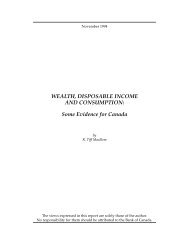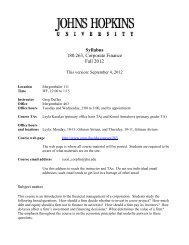Packet - Economics - Johns Hopkins University
Packet - Economics - Johns Hopkins University
Packet - Economics - Johns Hopkins University
Create successful ePaper yourself
Turn your PDF publications into a flip-book with our unique Google optimized e-Paper software.
Essays on Health Care Markets<br />
Matthew N. White<br />
1 An Ounce of Prevention at Half Price: Evaluating a Subsidy on Health<br />
Investments (job market paper)<br />
Thispaperexamineshowinvestmentsinhealth, throughpreventiveorcurativecare, dynamically<br />
affect health care purchasing behavior among the retired population. In particular,<br />
what would be the effects of lowering the price of health investments for some individuals?<br />
I estimate a structural model of the “retired life cycle” using data from the Health and<br />
Retirement Study on single retired Americans. I then conduct policy counterfactuals to<br />
ascertain the effect of a subsidy on preventive care on health outcomes, the total demand<br />
for health care, and public expenditures on health care for the elderly. A subsidy targeted<br />
at healthy, lower income individuals improves longevity by 0.76 months at a public cost of<br />
$760 per capita. However, the subsidy does not reduce total demand for health care over<br />
the remaining lifetime of the targeted population.<br />
2 The Role of Medical Inflation in Demand for Health Care (in progress)<br />
This paper uses the estimated model from the previous chapter to investigate the conflicting<br />
role of medical inflation in demand for health care among the elderly. The expectation of<br />
higher medical inflation should increase current purchases of health care as individuals seek<br />
to stay healthy and avoid large future costs. However, as time passes and higher medical<br />
pricesactuallyoccur, healthcarepurchasesshoulddecreasethroughapriceeffect. Iseparate<br />
these effects by simulating an environment where medical inflation is high but individuals<br />
do not adapt their beliefs, and an environment where individuals believe inflation will<br />
be high but it continues normally. I further separate three ways medical inflation affects<br />
government health care expenditures for the elderly: direct costs higher unit price, indirect<br />
savings through lower health investment reimbursements, and indirect costs through worse<br />
population health over time.<br />
3 Competition Among Medical Insurers and Consumer Welfare (in progress)<br />
Some recent proposals for health care reform rely on increased competition among insurers<br />
(e.g. through interstate sales of policies) to decrease health care and insurance prices. This<br />
paper presents a model to analyze price and competition in a three-way market among<br />
patients (consumers), medical providers, and health insurers. While insurers compete with<br />
each other for customers, they also act as a collective bargaining agent on behalf of patients<br />
in determining the equilibrium price of health care with providers. The entry of an additional<br />
insurer thus has contradictory effects on prices and consumer welfare, reducing prices<br />
through competition but increasing them through reduced bargaining power of incumbent<br />
insurers. The model is used to demonstrate that the welfare of patients is not necessarily<br />
increasing in the number of insurers.




